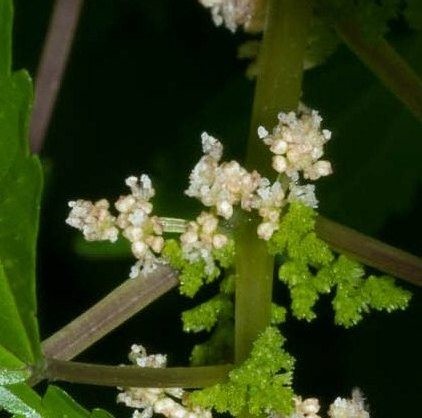Clearweed
(Pilea pumila)

Description
Pilea pumila, commonly known as clearweed,is an edible herbaceous plant in the nettle family (Urticaceae). It is native to Asia and eastern North America, where it is broadly distributed. This plant is most often found in rich loamy soil, usually in moist to wet areas. Its natural habitat is in forests or other lightly shaded conditions.It is a common plant throughout its range, and forms large colonies where it is found. It grows in both high-quality habitats and in ecologically degraded areas. Due to its high tolerance for disturbance, it is often seen near buildings and as a garden weed. Pilea pumila is an erect annual, growing 0.7 to 70 cm tall. The foliage is opposite, simple with dentate margins, wrinkly (with depressed veins), ovate, and with long petioles. Both the leaves and stems are translucent and bright green, turning bright yellow in autumn. The flowers are small, borne in axillary cymes, unisexual with both genders occurring on the same plant, greenish yellow, and pollinated by wind. Flowers bloom from midsummer through early autumn. Fruits (achenes) are green with purple markings. Roots are fibrous, shallow, and adventitious off the stem in moist areas or when in contact with the soil. The plant is often mistaken for stinging nettle (Urtica dioica), but can be distinguished by the lack of trichomes, or stinging hairs, and the lower amount of branching of the inflorescences. The majority of species are succulent shade-loving herbaceous plants or shrubs, which are easily distinguished from other Urticaceae by the combination of opposite leaves (with rare exceptions) with a single ligulate intrapetiolar stipule in each leaf axil and cymose or paniculate inflorescences (again with rare exceptions). The genus has attracted little monographic attention since Weddell (1869), and the majority of taxonomic contributions have come from floristic treatments. To date, 787 species names have been published (International Plant Names Index, 2003) and estimates for the species number range from 250 to 1000. Based on previous floristic treatments, about 30% of the species from regions not yet covered by contemporary floristic treatments may be undescribed. The genus name Pilea is Latin for "felt cap", a reference to the calyx covering the achene.
Taxonomic tree:







